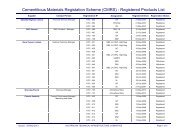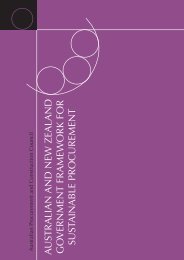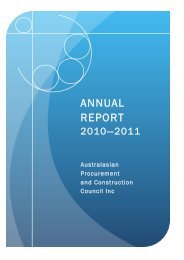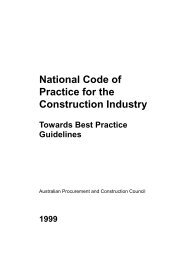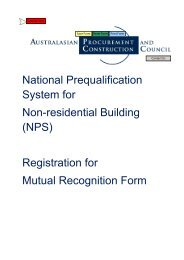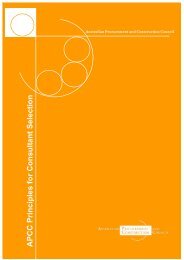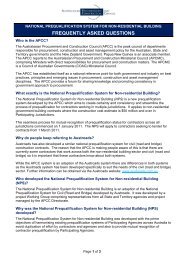Improving Security of Payment Building and Construction Industry
Improving Security of Payment Building and Construction Industry
Improving Security of Payment Building and Construction Industry
- No tags were found...
Create successful ePaper yourself
Turn your PDF publications into a flip-book with our unique Google optimized e-Paper software.
4. Trusts Page 34National Public Works Council Inc<strong>Improving</strong> <strong>Security</strong> <strong>of</strong> <strong>Payment</strong> in the <strong>Building</strong> <strong>and</strong> <strong>Construction</strong> <strong>Industry</strong>4.7 Problems, Difficulties <strong>and</strong> Legal Ramifications <strong>of</strong> TrustsThere are numerous problems, difficulties <strong>and</strong> legal ramifications from the use <strong>of</strong> trusts. Setout below are the main issues, outside the questions raised in the Brief (discussed at Section4.8) from the use <strong>of</strong> trusts.Most <strong>of</strong> the following discussion in Section 4.7 is based on the premise that the HeadContractor is the trustee. The ramifications for the trust scheme may be different where thetrustee is not the Head Contractor, but some third party.4.7.1 Trust AccountsThere are three possible trust structures available. These have been consideredpreviously, <strong>and</strong> can be described as single trusts, multiple trusts or cascading trusts.Irrespective <strong>of</strong> the structure adopted, trusts may be deemed (ie implied at law) orformal (ie expressed in formal terms such that their content is evident in trustdocumentation which in turn binds the parties).As indicated, one potential difficulty arising from the use <strong>of</strong> trusts occurs when trustfunds become mixed, either with monies from other trust funds held by the trustee, orwith the trustees own money, or both.It has been previously stated in this Consultancy that the likelihood <strong>of</strong> mixing <strong>of</strong> fundsis much less likely to occur in the case <strong>of</strong> cascading trusts.4.7.2 Monies Mixed in Trustee's AccountIf monies are mingled with the trustee's general account, they become unidentifiable.This means that tracing, in the case <strong>of</strong> an action brought for breach <strong>of</strong> trust, may not bepossible. There are three points to note where retention monies have been required tobe held on trust by Head Contractors:(i)(ii)(iii)As a result <strong>of</strong> the Head Contractor's fiduciary relationship with theSubcontractor, a Head Contractor was under a duty to set the monies aside in aseparate account. (Wates <strong>Construction</strong> (London) Ltd v Frantham PropertyLimited (Unreported) referred to in F Fitzpatrick Retention <strong>of</strong> Funds in<strong>Building</strong> Contracts [1991] New LJ 1007)The above proposition means that in the case <strong>of</strong> a solvent Head Contractor, aninjunction is available to the Subcontractor to secure funds, <strong>and</strong> an order canbe made setting aside as a separate trust fund a sum equal to that part <strong>of</strong> thesum owing as retention monies under the project. (Re Arthur S<strong>and</strong>ers Limited(1981) 17 BLR 125, 136)In the case <strong>of</strong> an insolvent Head Contractor who has not maintained separateaccounts, no injunction will be ordered to constitute the funds as in (ii) above.However, beneficiaries are also entitled, in certain circumstances, to trace


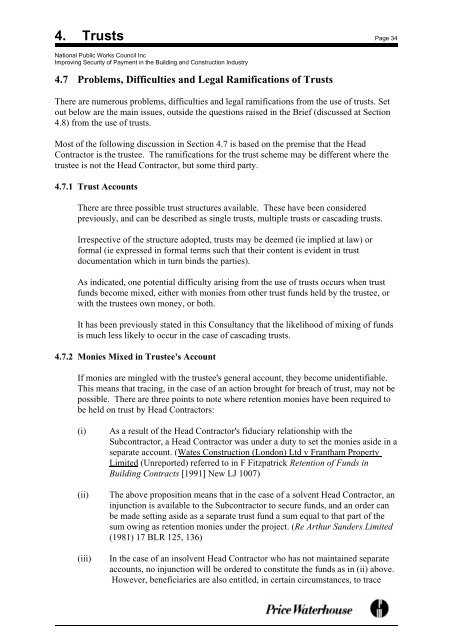
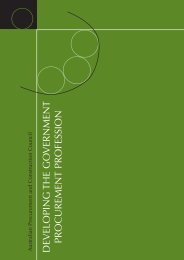
![NATIONAL COST ADJUSTMENT PROVISION EDITION 2 [NCAP2]](https://img.yumpu.com/48266135/1/184x260/national-cost-adjustment-provision-edition-2-ncap2.jpg?quality=85)
